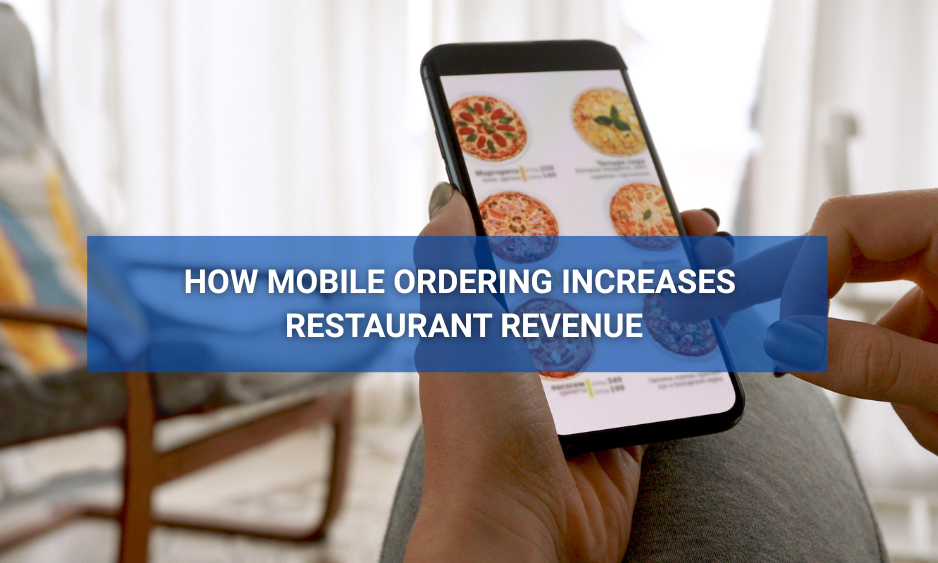How Mobile Ordering Increases Restaurant Revenue
Introduction
Mobile ordering is no longer a trend; it’s a necessity for restaurants that want to stay competitive in today’s market. The rise of mobile technology has transformed the way customers interact with businesses, and restaurants are no exception. In fact, mobile ordering has become a key driver of revenue growth for many restaurants, offering convenience to customers and operational efficiency to businesses. But how exactly does mobile ordering increase restaurant revenue? Let’s dive in.
Understanding Mobile Ordering
Mobile ordering allows customers to place orders for food and drinks using their smartphones or tablets, either through a restaurant’s mobile app or website. This process eliminates the need for in-person ordering, making it easier for customers to order ahead, customize their meals, and pay online. Mobile ordering has been particularly beneficial for restaurants that offer takeout and delivery, but it’s also valuable for dine-in experiences.
Benefits of Mobile Ordering for Restaurants
Increased Order Accuracy
Mobile ordering systems reduce human error. By allowing customers to input their orders directly, restaurants can avoid miscommunication and ensure that orders are accurate. This not only improves customer satisfaction but also cuts down on costly mistakes.
Enhanced Customer Convenience
Convenience is king, and mobile ordering provides just that. Customers can browse the menu at their leisure, place orders from anywhere, and schedule pick-up or delivery times that suit their schedules. This ease of use encourages customers to return more frequently.
Faster Service and Reduced Wait Times
Mobile orders allow restaurants to streamline operations and serve customers more quickly. By receiving orders ahead of time, kitchens can prep food faster, reducing wait times for both in-house diners and takeout customers.
How Mobile Ordering Increases Restaurant Revenue
Higher Order Volumes
With the convenience of mobile ordering, customers are more likely to place orders more frequently. Mobile apps also make it easier to engage with customers through push notifications, which can encourage repeat business.
Larger Average Order Sizes
Mobile ordering often leads to larger ticket sizes. When customers have more time to explore the menu on their own, they’re more likely to add extras like appetizers, desserts, or drinks to their orders. Additionally, mobile apps can suggest add-ons during the checkout process, leading to upselling and cross-selling opportunities.
Improved Upselling and Cross-Selling Opportunities
One of the key advantages of mobile ordering is its ability to offer personalized suggestions to customers. Restaurants can use data from past orders to recommend items that complement a customer’s order, such as offering a side dish or a larger portion size. This subtle upselling can significantly boost revenue.
Streamlining Restaurant Operations Through Mobile Ordering
Automation of Manual Processes
Mobile ordering automates many manual processes, such as taking orders and processing payments. This allows restaurants to operate more efficiently, reducing labor costs and minimizing errors. By freeing up staff from taking orders, they can focus on delivering a better customer experience.
Better Resource Management
With mobile ordering, restaurants can better anticipate demand, allowing them to manage inventory and staffing more effectively. Real-time data on orders enables restaurants to adjust kitchen operations on the fly, ensuring that they are adequately prepared during peak times.
Real-Time Data and Analytics
Mobile ordering platforms provide restaurants with valuable insights into customer behavior. Restaurants can analyze order history, peak ordering times, and popular menu items, enabling them to make data-driven decisions that boost profitability.
Improved Customer Loyalty with Mobile Ordering
Personalization Through Mobile Apps
Mobile apps allow restaurants to personalize the customer experience by offering tailored promotions, loyalty rewards, and recommendations based on past purchases. This level of personalization builds customer loyalty and increases the likelihood of repeat business.
Rewards and Loyalty Programs
Loyalty programs integrated into mobile ordering apps can incentivize customers to order more frequently. By offering points, discounts, or freebies for repeat orders, restaurants can encourage customers to keep coming back.
Convenience-Driven Repeat Business
The convenience of mobile ordering encourages customers to return regularly. Whether it’s for takeout, delivery, or even dine-in, the ability to order with just a few taps on their phone makes it easier for customers to choose your restaurant over others.
Expanding Customer Reach
Attracting Tech-Savvy Customers
Mobile ordering appeals to tech-savvy customers who prefer the convenience of ordering through their phones. This demographic is growing rapidly, and restaurants that offer mobile ordering can attract a younger, more digital-native audience.
Accessing Customers Outside Traditional Dining Hours
With mobile ordering, restaurants can extend their reach beyond traditional business hours. Customers can place orders in advance or order during off-peak times, helping to smooth out demand and increase revenue during slower periods.
Catering to Delivery and Takeout Trends
The rise of delivery and takeout has transformed the restaurant industry, and mobile ordering is at the heart of this shift. By offering a seamless mobile ordering experience, restaurants can capture more of the growing demand for off-premise dining.
Reducing Operational Costs
Less Reliance on Staff for Order Taking
By automating the ordering process, mobile ordering reduces the need for front-of-house staff to take orders. This not only cuts labor costs but also allows staff to focus on other tasks that enhance the customer experience.
Reducing Food Waste Through Accurate Orders
With mobile ordering, customers can input their specific preferences, reducing the chances of incorrect or wasted orders. Accurate orders mean less food waste, saving restaurants money.
Lower Transaction Costs with Digital Payments
Mobile ordering platforms often come with integrated payment options, which can lower transaction fees compared to traditional payment methods. Additionally, digital payments are faster, reducing the time staff spend processing payments.
Maximizing Marketing Opportunities
Push Notifications for Promotions
Mobile apps allow restaurants to send push notifications directly to customers’ phones. These notifications can be used to promote special offers, new menu items, or limited-time discounts, driving more orders and increasing revenue.
Gathering Customer Data for Targeted Marketing
Mobile ordering platforms collect valuable data on customer preferences and behavior. Restaurants can use this data to create targeted marketing campaigns, offering promotions tailored to individual customers based on their order history.
Offering Exclusive Mobile-Only Deals
Offering exclusive deals through your mobile app is a great way to incentivize customers to download and use your app. These deals can drive mobile orders and increase customer engagement with your brand.
Ensuring a Seamless Mobile Ordering Experience
To capitalize on the revenue-boosting potential of mobile ordering, it’s essential to offer a smooth, user-friendly experience. A mobile app should be easy to navigate, with a simple menu layout and an intuitive checkout process. Integration with your restaurant’s POS system is also key to ensuring that orders are processed efficiently.
Mobile Ordering and the Rise of Contactless Dining
The COVID-19 pandemic accelerated the shift to contactless dining, and mobile ordering became a lifeline for restaurants during this time. Customers could place orders and make payments without any physical interaction, making the dining experience safer and more efficient. This trend toward contactless service is expected to continue even post-pandemic, making mobile ordering a critical component of the modern dining experience.
Mobile Ordering as a Tool for Data Collection
Mobile ordering not only boosts revenue but also provides valuable insights into customer preferences and behavior. By collecting data on what customers order, when they order, and how often they return, restaurants can refine their offerings and tailor marketing efforts to drive more business.
Challenges of Mobile Ordering
While mobile ordering offers numerous benefits, it’s not without its challenges. Ensuring that your app or mobile platform is reliable and easy to use is critical to avoiding customer frustration. Additionally, balancing technology with personal service is important; not all customers may be comfortable using a mobile app, so offering traditional ordering options is still necessary.
Mobile Ordering Success Stories
Many restaurants have successfully increased their revenue by embracing mobile ordering. Quick-service restaurants (QSRs) like McDonald’s and Starbucks have seen tremendous growth through their mobile apps, offering seamless ordering experiences and loyalty programs. Independent restaurants have also benefited, using mobile ordering platforms to expand their reach and serve customers more efficiently.
The Future of Mobile Ordering in Restaurants
Looking ahead, the future of mobile ordering is bright. Emerging technologies like AI-powered chatbots, voice ordering, and even augmented reality menus are set to further enhance the mobile ordering experience. As these technologies become more accessible, restaurants will have even more opportunities to boost revenue through mobile ordering.
Conclusion
Mobile ordering has revolutionized the restaurant industry, providing customers with greater convenience while helping restaurants streamline operations and boost revenue. From higher order volumes to enhanced marketing opportunities, the benefits of mobile ordering are clear. For restaurants looking to stay competitive in today’s digital age, investing in mobile ordering technology is a must.
FAQs
How does mobile ordering boost customer satisfaction? Mobile ordering enhances customer satisfaction by offering convenience, personalization, and faster service, making the dining experience smoother.
Do all restaurants benefit from mobile ordering? Yes, mobile ordering can benefit both quick-service and full-service restaurants by improving efficiency and increasing revenue.
Can mobile ordering be integrated with third-party delivery apps? Yes, most mobile ordering platforms can be integrated with third-party delivery services, allowing restaurants to expand their reach.
What are the top mobile ordering platforms for restaurants? Popular mobile ordering platforms include Toast, Square, and ChowNow, each offering unique features tailored to restaurant needs.
How can restaurants promote their mobile ordering services? Restaurants can promote mobile ordering through social media, in-store signage, email campaigns, and by offering exclusive mobile-only deals.

